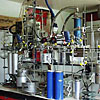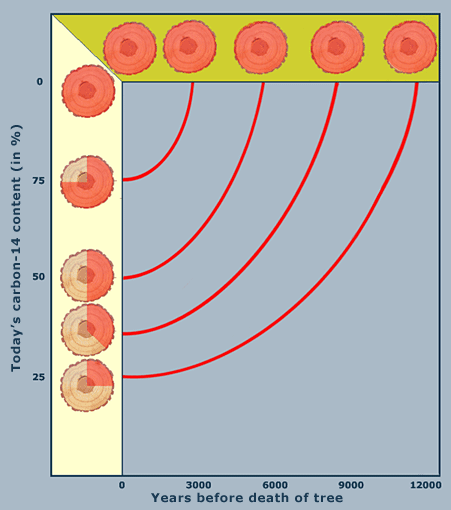 |
|
|
|
|
|
|
How does the radiocarbon method work? While an organism is alive, the decaying radiocarbon is continually replaced and the ratio of the instable 14C to the stable 12C remains constant and is the same as the ratio in the atmosphere. When an organism dies, the carbon intake ceases. From this point of time the amount of 14C decreases through time by its radiometric decay of 5370+/-40 years. After 5370 years only 50% of the original 14C content will be left. After 11460 years it decreases to 25%, after 17190 to 12.5% and so on. After about 60000-7000 years all the 14C will be gone. This is the reason why the use of the carbon-14 method is limited. In a radiocarbon laboratory the proportions of 14C and 12 in a sample can be measured. By comparing the measured values to a modern standard, the age of the sample can be determined. All radiocarbon ages refer to 1950 AD ("present") and is indicated as yBP (years before present) or simply BP (before present). A radiocarbon age of 1370 ± 70 yBP (years before present) for example means thet the organism died 1370 radiocarbon years before present with an 1-Sigma error (68,7%) of 70 radiocarbon years.
|
1 - Decreasing of the carbon-14 in accordance
with the radiometric decay of 5370 ± 40 years. |
Why do we say "radiocarbon years"? The content of the atmospheric carbon-14 varies over the
course of time due to the variations of the cosmic radiation intensity.
So 14C years do not represent solar years and therefore 14C ages have
to be calibrated by means of dendrochronology. Which branches in science use radiocarbon dating? There are many applications of radiocarbon dating in a variety of different fields of sciences. For eaxample, carbon 14C is used in archaeology, study of historical monuments, quaternary landscape evolution, oceanography, palaeoenvironmental sciences, vegetation history and glacial history. |
|
http://id-archserve.ucsb.edu/Anth3/Courseware/Chronology/08_Radiocarbon_Dating.html |
29 August 2011 |
||
| |
||
 Radiocarbon
or carbon-14 dating is one of the most used dating methods for quaternary
events as far back as 60'000-70'000 years. The carbon-14 method is based
on the decay rate of the unstable carbon isotope 14C which is produced
in the upper atmosphere as a consequence of cosmic-ray bombardement. It
oxidised quickly to 14CO2 and is incorporated by organisms like plants
and animals through photosynthesis and biological food chain during their
lifetime. It follows from this that any material which is composed of
carbon may be dated. The carbon-14 is able to be uniformly applied throughout
the world.
Radiocarbon
or carbon-14 dating is one of the most used dating methods for quaternary
events as far back as 60'000-70'000 years. The carbon-14 method is based
on the decay rate of the unstable carbon isotope 14C which is produced
in the upper atmosphere as a consequence of cosmic-ray bombardement. It
oxidised quickly to 14CO2 and is incorporated by organisms like plants
and animals through photosynthesis and biological food chain during their
lifetime. It follows from this that any material which is composed of
carbon may be dated. The carbon-14 is able to be uniformly applied throughout
the world. 